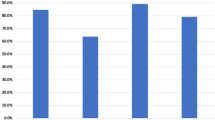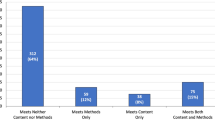Abstract
This article reports on a national survey of higher education institutions in the United States to answer the question, “Who teaches mathematics content courses for prospective elementary teachers, and what are these instructors’ academic and teaching backgrounds?” We surveyed 1,926 institutions, and a faculty member from each of 825 institutions (42.8 %) participated in the survey. The survey results demonstrate that the majority of institutions are not meeting the recommendations of the Conference Board of the Mathematical Sciences (The mathematical education of teachers. American Mathematical Society, Providence, RI, 2001), the National Council of Teachers of Mathematics (Professional standards for teaching mathematics. National Council of Teachers of Mathematics, Reston, VA, 2005), and the National Council on Teacher Quality (Greenberg and Walsh 2008) for prospective elementary teachers to take at least nine credits of mathematics content designed specifically for them. Additionally, most instructors for these courses do not have elementary teaching experience and have likely not had opportunities to think deeply about the important ideas in elementary mathematics, and most institutions do not provide training and/or support for these instructors.


Similar content being viewed by others
References
Ball, D. L., & Bass, H. (2000). Interweaving content and pedagogy in teaching and learning to teach: Knowing and using mathematics. In J. Boaler (Ed.), Multiple perspectives on the teaching and learning of mathematics (pp. 83–104). Westport, CT: Ablex.
Bass, H. (2005). Mathematics, mathematicians, and mathematics education. Bulletin of the American Mathematical Society, 42(4), 417–430.
Conference Board of the Mathematical Sciences. (2001). The mathematical education of teachers. Providence, RI: American Mathematical Society.
Greenberg, J., & Walsh, K. (2008). No common denominator: The preparation of elementary teachers in mathematics by America’s education schools. Washington, DC: National Council on Teacher Quality.
Hodgson, B. (2001). The mathematical education of school teachers: Role and responsibilities of university mathematicians. In D. Holton (Ed.), The teaching and learning of mathematics at university level (pp. 501–518). Dordrecht, The Netherlands: Kluwer.
Lutzer, D. J., Rodi, S. B., Kirkman, E. E., & Maxwell, J. W. (2007). Statistical abstract of undergraduate programs in the mathematical sciences in the United States. Washington, DC: American Mathematical Society.
Ma, L. (1999). Knowing and teaching elementary mathematics: Teachers’ understanding of fundamental mathematics in China and the United States. Mahwah, NJ: Lawrence Erlbaum Associates, Inc.
Mathematical Sciences Education Board. (1996). The preparation of teachers of mathematics: Considerations and challenges: A letter report. National Research Council. Retrieved September 21, 2010 from http://www.nap.edu/catalog/10055.html.
Matthews, M. E., & Seaman, W. I. (2007). The effects of different undergraduate mathematics courses on the content knowledge and attitude towards mathematics of preservice elementary teachers. Issues in the Undergraduate Mathematics Preparation of School Teachers, 1. Retrieved August 10, 2010 from http://www.k-12prep.math.ttu.edu.
McCrory, R., Zhang, C., Francis, A. P., & Young, S. (2009). Factors in the achievement of preservice elementary teachers in mathematics classes. In S. L. Swars, D. W. Stinson, & S. Lemons-Smith (Eds.), Proceedings of the 31st annual meeting of the North American chapter of the international group for the psychology of mathematics education (Vol. 5, pp. 1179–1187). Atlanta, GA: Georgia State University.
National Council of Teachers of Mathematics. (1991). Professional standards for teaching mathematics. Reston, VA: National Council of Teachers of Mathematics.
National Council of Teachers of Mathematics. (2005). Highly qualified teachers: A position of the National Council of Teachers of Mathematics. Retrieved April 21, 2011 from http://www.nctm.org/about/content.aspx?id=6364.
National Science Foundation. (1998). Investing in tomorrow’s teachers: The integral role of two-year colleges in the science and mathematics preparation of prospective teachers. A Report from a National Science Foundation Workshop. Retrieved October 19, 2010 from http://www.nsf.gov/pubs/1999/nsf9949/nsf9949.htm#role.
Olanoff, D. E., Kimani, P. M., & Masingila, J. O. (2009). Learning to teach via problem solving and supporting pre-service teachers in learning via problem solving. In Proceedings for the 31st annual meeting of the North American chapter of the international group for the psychology of mathematics education, Atlanta, GA.
Seaman, C. E., & Szydlik, J. E. (2007). Mathematical sophistication among preservice elementary teachers. Journal of Mathematics Teacher Education, 10, 167–182.
Snyder, T. D., & Dillow, S. A. (2010). Digest of education statistics 2009 (NCES 2010–013). Washington, DC: National Center for Education Statistics, Institute of Education Sciences, US Department of Education.
Sztajn, P., Ball, D. L., & McMahon, T. A. (2006). Designing learning opportunities for mathematics teacher developers. In K. Lynch-Davis & R. L. Rider (Eds.), The work of mathematics teacher educators: Continuing the conversation, AMTE Monograph 3 (pp. 149–162).
Acknowledgments
The authors thank Amy L. Cunningham and Anuj M. Kachapati for their assistance in data collection and data analysis, respectively.
Author information
Authors and Affiliations
Corresponding author
Rights and permissions
About this article
Cite this article
Masingila, J.O., Olanoff, D.E. & Kwaka, D.K. Who teaches mathematics content courses for prospective elementary teachers in the United States? Results of a national survey. J Math Teacher Educ 15, 347–358 (2012). https://doi.org/10.1007/s10857-012-9215-2
Published:
Issue Date:
DOI: https://doi.org/10.1007/s10857-012-9215-2




